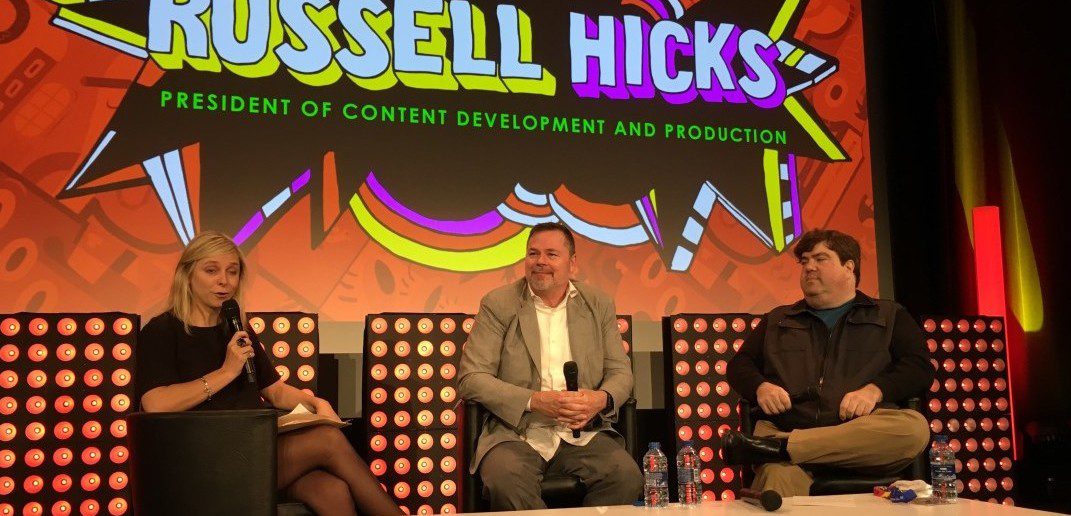Between them, Russell Hicks (centre) and Dan Schneider have brought some of the most popular children’s TV shows of recent years into being, from iCarly, Drake & Josh and Sam & Cat, to current hit Game Shakers.
Hicks and Schneider were the stars of today’s MIPJunior keynote session, talking about their work, and the challenges of holding children’s attention in a world of ever-proliferating platforms and content.
How are children’s tastes in entertainment changing? « The world has gotten smaller due to the internet and smartphones and tablets that every kid is on. It’s smaller, but there’s still a need for local, » said Hicks. « They wanna see their own backyard, things that they’re familiar with. But they also want to see things they’re not familiar with, that are surprising… We are building content everywhere today. » From the Netherlands and Spain to the UK, in Europe.
What defines great children’s programming today, given the glut of competition. « At the end of the day, kids gravitate towards great characters, characters they can relate to, who tell stories true to them, » said Hicks. « That’s what they’re searching for. It needs to be great storytelling, otherwise there’s just a lot of content… So they’re looking for new, fresh ideas, but still relatable to what they’re going through in their life. »
Schneider talked about the change in the variety of content available to kids since he joined Nickelodeon 21 years ago. « There are so many distractions for kids and so many places they can get shows. That’s the biggest challenge for me, » he said. « I find myself working harder now than I ever have before. I don’t spend a lot of time looking at everything else out there and analysing. I don’t even really watch competitive shows… I just work even harder to make the scripts entertaining, and I work even harder to cast… so that people will hopefully choose the shows that we make. »
What are the children who watch Nickelodeon shows today like, and how does that affect the broadcaster’s work? Hicks talked about the importance of research into that audience, citing the difference now to the children who watched in the broadcaster’s early days. « They were the latch-key kid they came home, there were no parents. We were their parent! » he said.
« Fast forward to today, kids are completely different. Technology has changed their lives. The child born today is a digital native… Their parents are completely involved in their lives, they’re helicopter parents. They’re velcro parents. They’re on their child 24-7 and the child likes it. »
He noted that parents and children watch TV together, listen to similar music and « even dress alike », but added that the average eight year-old has « seen a lot of media » so is quicker to realise when a show is just a formulaic retread of a previous format.
How does Nickelodeon connect with children on other devices? « I remember in the late 90s, I would see a lot of television producers get very nervous about the web: ‘this is competition and this is going to take away our audience’. I never viewed it that way, » said Schneider.
His iCarly and The Amanda Show programmes were innovative in the way they had additional content online for viewers to explore. « I felt like this is a great thing. We don’t just have to put content on television: we can put content online… I just view it as the more screens kids have, the more they need stuff to watch on those screens. »
Hicks talked about launching shortform video through the Nick app, and then turning the ones that resonate best with children into full series for television. « You can start it out small and do just a web series, and say ‘hey, this is actually working and take it further’, » he said.
Schneider talked about the role of social media. « 1,000%, which of course is dangerous… I get a lot of love on the internet, but there’s also plenty of people going ‘How come on iCarly Freddie and Sam never got together? Drop dead Dan Schneider!’. So you take the good with the bad, » he said.
The conversation turned from iCarly to Game Shakers. iCarly was originally called Starstruck, about a girl who got cast in her favourite TV show. It made it to a script, before Schneider rethought the idea to make it « a little bit more progressive, a little bit more now » by being about a girl who created her own web show, rather than appearing in someone else’s.
« Game Shakers is a bit similar. It’s an amazing cast of kids, there’s a little similarity in the DNA to iCarly in that you have these four kids who created this video game which takes off… and they say ‘hey, let’s start a video game company’. That’s so much more fun than a show about kids just playing video games. And it’s very empowering, because it’s run by two girls, and the boys work for the girls. »
The games are real: they’re launched online and on app stores. ‘It was the number one free app for a week or so, » said Schneider. « It’s doing incredibly well, » agreed Hicks. « And we will release more games as the show creates more games. »
The conversation turned back to what draws kids to programming. « Well, I think it’s the characters. No one goes ‘oh gee, that format’s really interesting’, » said Hicks. « It’s got to start with character, and from there build. » Schneider agreed. « People fall in love with the characters… When I used to watch Brady Bunch I never thought ‘well, that was an incredibly well-written episode’, » he said.
What does Schneider look for in his young stars? « Even when I cast the small supporting characters, I scrutinise them just as much as the lead characters, because I’m always farming for the next show, » he said. « I’m pretty relentless. Just for those Game Shaker kids, I bet my casting directors probably saw 600-700 kids for every role… It’s a really slow, whittling-down process. » He writes specific audition scenes that « really force an actor to jump through a lot of hoops: can you play angry, can you play emotional, can you play crying?.. They really separate the amateurs from the professionals. »
Finally, is television still the most important screen for capturing kids’ attention? « I don’t think it matters. I don’t think the screen matters, » said Schneider. « The more screens out there, the better. Let’s have more watches that can show our TV. Television is pictures and sound, and if they’re watching it on a screen, and they’re watching our stuff, we’re winning… I don’t feel television is threatened at all by the Internet, by the portable screens. If they’re holding them in their hands, they wanna look at something entertaining. I hope it’s our stuff: we try hard to make it our stuff. »
« We don’t have a television issue. Television is not going away. We have a measurement issue. They do not measure all the places they [kids]are watching content, » added Hicks. « When they fix that problem, we’ll find out: they love content everywhere. »




